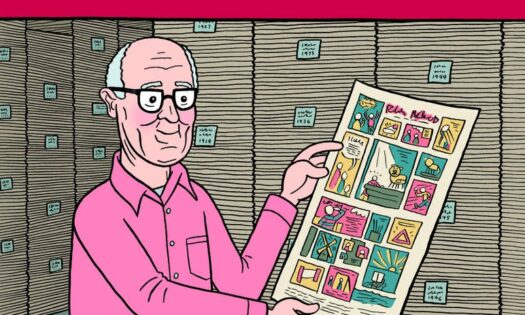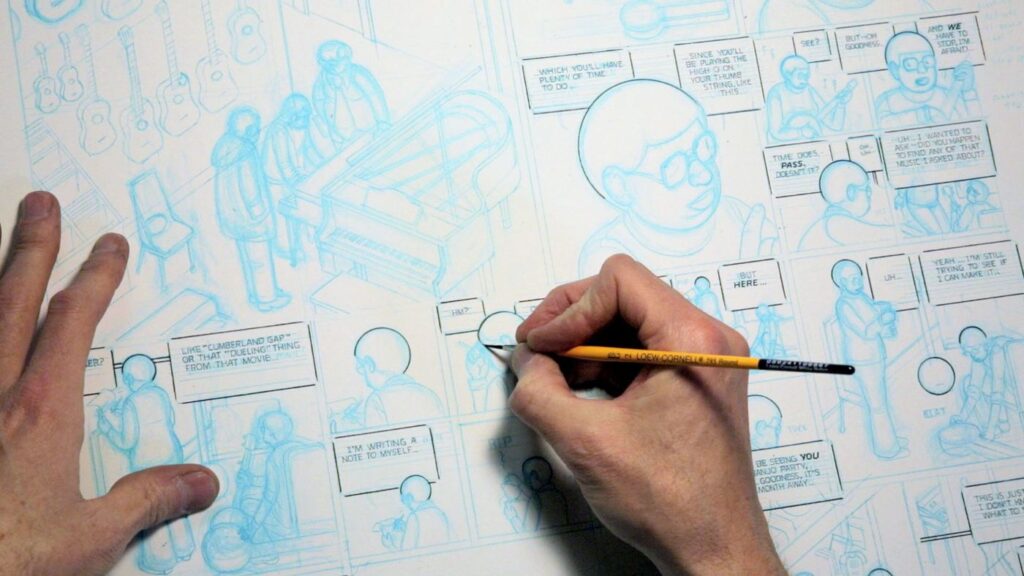
My Modern Met recently featured the photographs of Nicolas Miller, who specializes in neo-noir city pictures that (in the words of Met writer Madeleine Muzdakis) “capture the cinematic nature of everyday life among the overpasses, high-rises, and neon signs.” The noir aesthetic emphasizes darkness, isolation, and absence, and you can see dozens of haunting, poetic images like the one above on Miller’s Instagram.
 I’ve mentioned Ohio State University’s Billy Ireland Cartoon Library and Museum before. As the world’s largest repository of cartoon research materials (original art, magazines, etc.), the Billy Ireland is a must-visit destination for any comics fan and scholar. Now the Billy Ireland has released a free, downloadable 16-page comic book, Bill Blackbeard: The Collector who Rescued the Comics. Researched by Jenny Robb, Curator and OSU Associate Professor, and written and drawn by Alec Longstreth (whose terrific online strip Isle of Elsi we linked to in Comics Club issue #1), Bill Blackbeard tells the story of a collector who passionately amassed hundreds of discarded, bound newspaper runs from libraries, an activity that preserved 20th century American comic strips. Spoiler alert: Blackbeard then donates his collection—all seventy-five tons—to the Billy Ireland. Download and read the fascinating story here; read celebratory obituaries for Bill Blackbeard here, here and here.
I’ve mentioned Ohio State University’s Billy Ireland Cartoon Library and Museum before. As the world’s largest repository of cartoon research materials (original art, magazines, etc.), the Billy Ireland is a must-visit destination for any comics fan and scholar. Now the Billy Ireland has released a free, downloadable 16-page comic book, Bill Blackbeard: The Collector who Rescued the Comics. Researched by Jenny Robb, Curator and OSU Associate Professor, and written and drawn by Alec Longstreth (whose terrific online strip Isle of Elsi we linked to in Comics Club issue #1), Bill Blackbeard tells the story of a collector who passionately amassed hundreds of discarded, bound newspaper runs from libraries, an activity that preserved 20th century American comic strips. Spoiler alert: Blackbeard then donates his collection—all seventy-five tons—to the Billy Ireland. Download and read the fascinating story here; read celebratory obituaries for Bill Blackbeard here, here and here.

Over on his weekday blog “The Daily Heller” on the Print website, Stephen Heller continues to write engagingly about past and present visual culture. On March 12, Heller interviewed Yulia Popova, author of the new book How Many Female Type Designers Do You Know? I Know Many and Talked to Some!—featuring biographies of important but neglected women type and graphic design artists. And in a new series, “The Assistant,” Heller speaks with “unsung designers” employed by more renowned artists and firms, including Ignacio Serrano, who worked at Milton Glazer’s studio for three years (2017-2020), and Camille Murphy, a design professor who collaborates with Seymour Chwast. Check out all the recent “Daily Heller” posts here.

The National Film and Sound Archive of Australia (NFSA) is making available online some of the movies in the Corrick Collection! The Corricks were a family of vaudeville entertainers (usually billed as either “The Corrick Family Entertainers” or “The Marvellous Corricks”) who performed for audiences in Australia, Southeast Asia, and Europe between 1897 and 1914. Beginning in 1901, the Corricks incorporated movies into their show. (One included was Babylas Vient D’Heriter D’une Panthere [“Babylas has just inherited a panther”], a 1911 French short, pictured above.) These movies—along with such ephemera as photographs, playbills, and tour memorabilia—have been preserved and restored by the NFSA. Go here for more information about the Corricks; go here for an overview of the restoration process; or dive right into this YouTube playlist to see five of the earliest movies ever made.
George Gately’s Heathcliff, a comic strip about a neighborhood cat stealing fish and causing trouble, appeared first in newspapers in 1973, five years before Garfield. In 1998, Gately’s nephew, cartoonist Peter Gallagher, took over Heathcliff, and recently has made the strip weirder and weirder, abandoning traditional gags in favor of what Max Genecov of The Outline calls “accidental normcore Dadaism”: “It doesn’t seem to contain jokes per se—go through a few weeks’ worth of panels, though, and they develop an internal rhythm that doesn’t quite make sense, but nevertheless feels like it does.” Another commentary on Heathcliff’s escalating strangeness is offered by GoComics’ Stephen Roth, who gives samples of such offbeat recurring gags as “The Garbage Ape” and Heathcliff’s penchant for strange helmets. Why not head over to GoComics and experience Heathcliff’s oddness for yourself?
For the Spring 2021 issue, the online School of the Art Institute of Chicago Magazine features a profile of Chris Ware, influential comics artist and SAIC graduate school alumnus. Illustrated with images from Ware’s graphic novels Jimmy Corrigan: The Smartest Kid on Earth (1999) and Building Stories (2012), as well as one of his New Yorker covers, the article highlights Ware’s talent and his own attitude of pitch-black, humorous pessimism; Ware describes his time at SAIC, for instance, as both “a wonderful two years of self-consciousness, self-doubt, self-misery, and crushing loneliness” and “two years that provided lifelong friendships.” Ware’s graphic novels are only for adult readers, but this profile is all-ages, and should be read by anyone who wants to make art that reflects their personal vision rather than the opinions and ideas of others.
Below is Ware’s cover for the SAIC Magazine, featuring vignettes of a quiet pandemic Chicago.

This weekly blog post is written and compiled by Craig Fischer. To send along recommendations, ideas, and comments, contact Craig at [email protected] [.]




